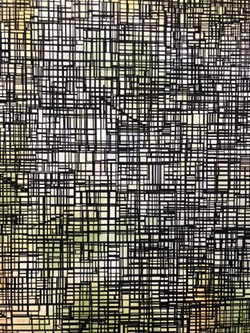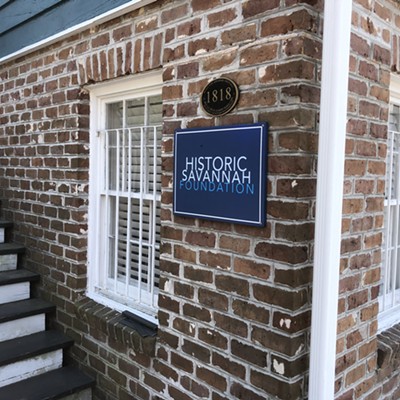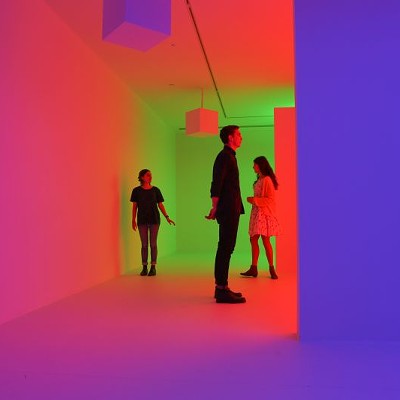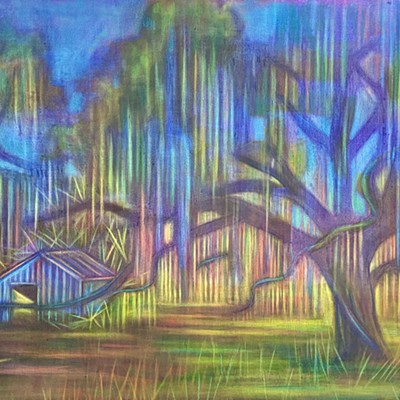YOU MIGHT leave Patricia K. Hecht’s exhibition feeling a little claustrophobic.
“You Are Here | Exit Unlikely” explores architectural repurposing, beginning with prisons and insane asylums and ending with our own familiar structures. The work is a dizzying array of meticulously drawn black line.
We spoke with Hecht last week.
1. How did you come up with the idea for this show?
Hecht: Well, the only reason I ended up researching any of this was because I fell down a rabbit hole after reading a Vice article on Rosemary Kennedy [laughs].
The initial interest was mostly monochromes of floor plans of insane asylums and prisons in this country. This panel is based on the Kirkbride model, which is what you think of when you think of an insane asylum. Then I moved from there in my research, and it became very evident that after the deinstitutionalization, prisons became asylums. There are more mentally ill people in prisons, but there are no technical asylums under the privatized system.
Then with the whole privatization of prisons, they medicate some of the prisoners, but they’re not told how to maintain this medication when they get out of prison, so they end up going back to street drugs getting busted for that, and in turn going back into the prison system. Once you’re in these systems, you’re not out of them.
As I was doing more research, it became apparent that my interest wasn’t just in the institutionalized aspect of these places, but really in how a ton of the asylums that were really populated are now colleges or dorms or repurposed buildings somehow. A lot of the housing projects were based on urban layouts and architectural designs from heavy-hitting modernist designers. But they’re always misconstrued in some sort of way. The idea of making these effective, low-priced houses that can really give you the biggest bang for your buck. They all had green spaces and room to breathe and certain aspects that as an artist or architect, it made sense, but to someone who’s actually living in them, it didn’t make sense.
2. How did the project evolve?
Hecht: I wanted to do something more personal, but not too personal—I’m interested in a bigger picture. One collage has Sunny Isles Beach, Florida, and Rockville Center, Long Island. Both places are recognizable, and they’re together because my grandmother lived in Sunny Isles and my nana and papa lived in Rockville Center. These are the aerials of both places and certain floor plans. I ended up being able to find the floor plan of her apartment, and I remembered my nana and papa’s so I laid that in.
With all these, I use Google source images. Even though I have pictures for all these places, I use Google Source Image to play to this idea of the lack of tangible memory we actually have and the lack of memory that Google’s been telling us we have.
So, one thing I Googled was Mellow [Mushroom, on Liberty St.], which is deep-seated in my Savannah experience. When I Googled Mellow, the green awning came up. If you moved here in the last three years, you haven’t seen the green awning, but that’s what Google is telling you the Savannah Mellow looks like. It’s this weird collective.
3. What’s your process of creating these?
Hecht: I put them into Photoshop and make a collage out of the sourced images, and then I paint them in and draw them in pretty realistically. Then I go back and blur them out.
On the panels I make, the first projection aspect is the color, but after that I end up printing out the maps on a transparency or put them in Photoshop. If I pull it off Google Maps itself, I have to put it in Photoshop and tinker with it to make them do what they should do. The black and white panels have a little acrylic on them, but for the most part, they’re done with Staedtler pens, which is a fancy, insanely permanent Sharpie.
4. Tell me about the performative aspect of this show.
Hecht: The lines on the wall, I just used the transparency for the piece it correlates with. I’m going to bring these lines down to mark off some dimensions to be like, “Hm, this is where we are,” which is hopefully what this wall element is doing—pulling these pieces from the piece.
5. What did you take away from doing this project?
Hecht: Architecture, unless it’s really good or really bad, you just kind of live with it. Buildings are repurposed for the most part, but asylums are built on the height of psychiatry to have all this air flow. Psychiatry is an ever-growing thing, so there’s this idea that these buildings we’re in were something else, but we’re still good with that.
Alain de Botton wrote “The Architecture of Happiness” and does a segment about how architecture and interior design is a weird thing to talk about, because it’s really hard to pinpoint when something is off. It sounds weird to say, “Something just feels different.”
It’s not just institutions, it’s all these repurposed buildings, this cycle we’re in. Until you understand where you are and what you’re doing, it’s impossible to break out of that cycle. You tend to not notice.



























